You might also be interested in:
Nammo short documentary about ramjet missiles
Nammo short documentary about ramjet artillery
Ramjet technology – Quick facts:
- A ramjet is a form of airbreathing jet engine that uses the engine’s forward motion to compress incoming air without an axial compressor or a centrifugal compressor.
- Ramjets work most efficiently at supersonic speeds around Mach 3 (2,300 mph; 3,700 km/h). These engines can operate up to speeds of Mach 6 (4,600 mph; 7,400 km/h).
- Ramjets can work both in smaller projectiles like 155mm artillery shells, as well as in larger missiles.
- Boeing and Nammo have signed a teaming agreement to jointly develop and produce the next generation of extended range artillery projectiles – utilising ramjet technology.






























